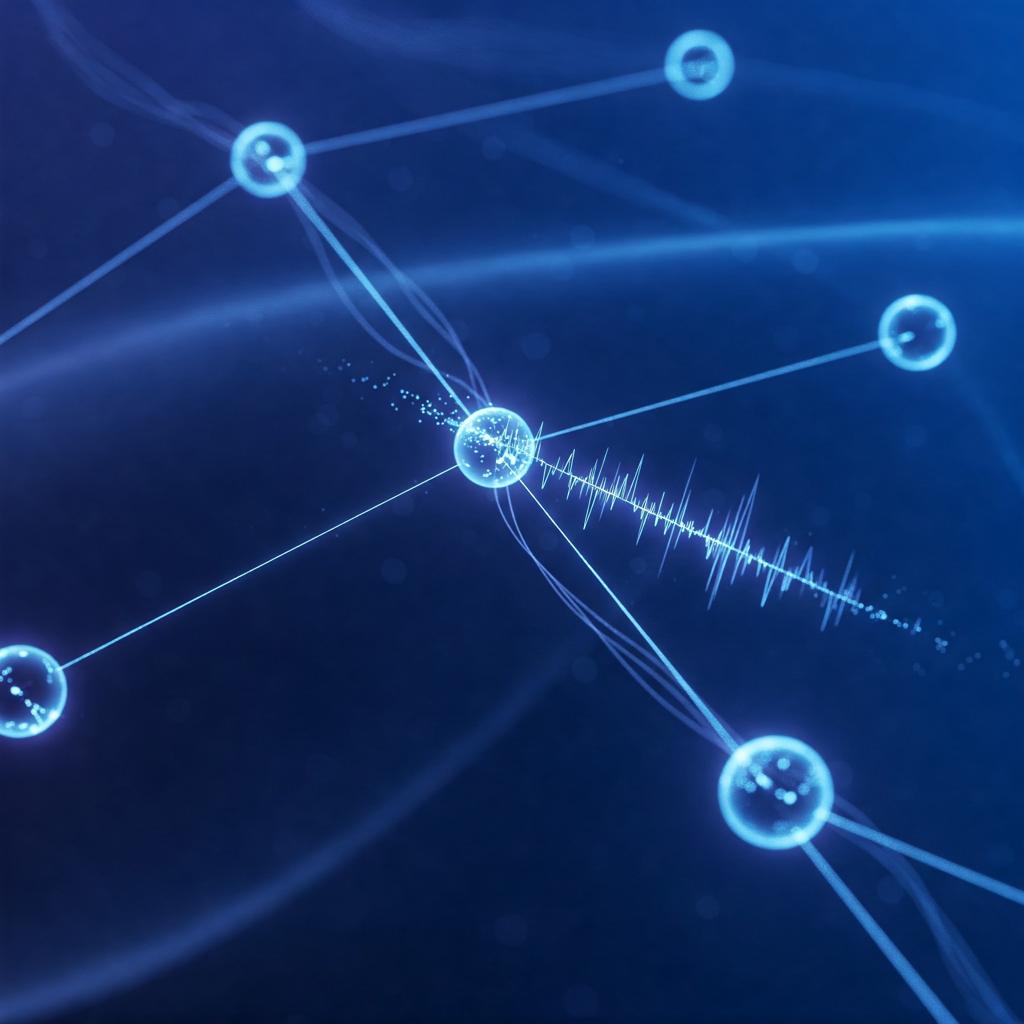
Low-Entropy Sync for Quantum Network Nodes
In any distributed system, whether sensor network on the ground or satellite network or nodes in the quantum internet of the future, it's crucially important that they all pass time in one common way. Without a common reference point, data is unusable, communication fails, and coordinated activity collapses.
Since other participants of a race are supposed to start simultaneously, computer systems (in this case, quantum) must have the same and identical timestamp to operate.
How It's Done Today
Classic computer networks are synchronized in time using protocols developed over many decades:
NTP (Network Time Protocol): The well-known protocol offers synchronization to the scale of milliseconds, and network computers are synchronized based on a mutual common standard time.
PTP (Precision Time Protocol): PTP is employed when more precision is needed. It can synchronize devices to microseconds or less based on the network configuration.
Such protocols by default become time-consuming since measurable, communicable, and clockable across systems without affecting any real disturbance or change with underlying processes. Such an assumption is in reality opposite to assumptions in quantum mechanics where measurement or communication causes extensive changes to the system state. With the appearance of quantum technologies, such protocols of standards face tough challenges to substantiate exotic quantum system behaviors.
Enter the Quantum World
Quantum mechanics is very different from how things operate in classical mechanics. Particles exist in a state of indeterminate overlap or, if I can be more precise, they're not actually in one place or with one particular momentum until you measure them. The process of measurement will change their state, and that's what gives quantum systems this richness of processing simply not present in classical systems.
Quantum clocks, perhaps based on atomic transitions, spin states, or photons, are very accurate, even in comparison to omnipresent clocks. Accuracy is expensive, though: they are very sensitive, very fragile and susceptible to interference. Any slight changes in the environment will make them desynchronize.
And besides, these strange, infinitesimal quantum systems typically have to get along with each other or be in some big network. Quantum clocks, or quantum machines for that matter, if they have to be synched up within an apparatus or a network, well, things are worse off. Similar to ordinary clocks, the quantum systems must jam together like a band, but syncing within the quantum system is much more difficult.
Why It's So Hard
It is very simple to synchronize classical clocks because one has very well-known methods and tools. But in quantum systems, one encounters incredibly more advanced problems:
Quantum clocks can be destroyed while they are being measured: Quantum mechanical systems actually can be changed by measuring it. Measuring the time of a quantum clock, therefore, would most probably change or disrupt it, so that it would be very hard to synchronize it.
You can't replicate quantum information because of the no-cloning theorem: Unlike copying classical information simply, quantum information can't be accurately copied like in the no-cloning theorem. It's a major deterrent when duplicating or moving accurate timing information without errors.
Quantum states dephase extremely rapidly under disturbance: Quantum systems are extremely sensitive to extrinsic disturbances, e.g., electromagnetic noise or vibrations. As a result of being extremely sensitive, the quantum states dephase extremely rapidly, i.e., their precision timing ability becomes ineffective.
Energy constraints: Certain quantum devices, i.e., those in quantum clocks, must be either at ultralow temperature or isolated. It is difficult and costly to replicate these conditions and serious problems arise in scaling the quantum systems into useful, real-world conditions.
Actually, timekeeping at the quantum level is a tender and gentle process, such as soap bubbles in a wind tunnel very precise and sensitive, which will have to be handled delicately or they burst.
What Scientists Are Trying
Researchers are developing new approaches that exploit the strangeness of quantum mechanics, operating with quantum strangeness instead of trying to work around it:
Quantum entanglement: This is creating pairs of particles in some state of "entanglement" with one another even when they may be spatially separated. This would presumably provide a quantum system synchronization mechanism without classical signaling. With control over this entangled state, researchers hope to be able to attain highly accurate synchronization of quantum networks.
Single-photon transmission: In this, a photon is transmitted and received individually by single time one particle of light, i.e., a single photon is used at a time per transmission cycle with each particle able to carry very accurate timing information. It's extremely low-power and has numerous benefits to usability where there are closely constrained supplies of power, i.e., space-borne applications or small sensors placed in products. Low-energy communication occurs without degrading timing information.
These new techniques utilize quantum effects like entanglement and superposition to solve the problem of synchronization, and thereby facilitate new avenues in quantum computation and communication.
Classical vs Quantum Timekeeping
Classical clock systems employ clocks which report to one another about signals to try and measure and allow for clock delay. Measurement of time, reporting of the measurement, and compensation for synchronization needed to stay in sync with clocks are all part of it. They function very well in well-structured, well-disciplined settings.
But quantum clocks would make it so much darker to cope with such a problem where every encounter is also haunted by a threat:
Quantum state is perturbed by measurement: Measurement or observation of the quantum system's state will perturb it according to the quantum mechanical principles, e.g., Heisenberg uncertainty principle. I.e., the measurement of time can perturb the system and synchronization will be a problem.
Information can't be copied or transferred unlimitedly: Quantum information differs significantly from classical information. Quantum information can't be copied or replicated, according to the no-cloning theorem, and is therefore more difficult to transfer or back up perfect time information without loss.
Accuracy may reduce when the energy is low or when the surroundings are noisy: Quantum systems are highly susceptible to external sources such as environment noise or low energies. These interference events decohere and lead to accuracy loss when it comes to measuring time.
Time, when referred to in the context of quantum clockmaking, is a quantum variable — one that needs to be handled with greater caution and care. Although, in classical systems, time is a measurable value, time in quantum systems is a fluctuating and a sensitive variable and needs to be handled by sophisticated techniques in such a manner that its accuracy is not marred.
Promising Concepts: Entanglement and Photons
Entanglement
Picture two enigmatic coins that never strike the same faces no matter how they're tossed light-years or so apart from one another. That's entanglement. Use it for clock synchronizations and never ever broadcasting a time signal.
Single-photon timing
Or transmit one photon by another photon, each and every one time-stamped stamped. It is feasible with nearly zero energy and relying on no flashy infrastructure — perfect for small or remote quantum hardware.
Which Method is Best
Your choice will be based on the actual application and requirement:
Entanglement is of the highest order of precision and hence most suited for those applications where highest precision is an absolute requirement. Thus, it suggests maximum technical refinement and exposure, which poses the question of utilization in practice. Exposition to outside influence and requirement of high-grade regulation makes scaling a problem.
Single-photon protocols are easier to use and handier for most applications, particularly in situations in which hardware simplicity in limitation or low energy levels are major factors to be attended to. Single-photon protocols are easier to implement and more resistant to single types of interference but possibly less accurate than protocols based on entanglement.
Finally, the ideal solution will hinge on usage, available source of energy, and desired precision. The ideal solution for most applications perhaps will be a hybrid sort but still efficient and precise.
There are a few issues that presently exist that will need to be solved before being able to move forward on quantum clock synchronisation:
Hardware is bulky or fragile: Modern quantum clocks and equipment would require laboratory conditions, i.e., supercooling or vacuum, to perform optimally. This renders them unavailable for everyday use or mobility in field environments in most applications.
Environmental noise degrades coherence, a prerequisite for proper timekeeping. External systems are highly susceptible to interference, and any slight change in temperature, magnetic fields, or vibrations will easily destroy their delicate state and render them unstable and inaccurate.
Synchronization is hard to ensure: It is itself hard to verify if quantum clocks are well aligned or well synchronized. Perhaps measurement or observation of the clocks will perturb the system and, in the process, ruin or even spoil the ideal synchronization that one would want to confirm.
Scaling up big systems of good ones remains the daunting challenge: Achieving clock synchronization in quantum systems to scale is just as much a necessary task as making systems that are not only correct but scalable and fault-tolerant too. It is about overcoming extremely draconian engineering and technical challenges so that quantum systems can run in many and less-constrained environments.
Why It Matters for the Future
If synchronisation of quantum clocks is to be made available and accessible in the near future, it will open up a collosal range of transformatory possibilities of which are:
Ultra-sensitive arrays of quantum sensors for sounding worlds below the earth, monitoring global climate change in vastly finer way than now and for gravitation wave detection with vastly greater precision than on current technologies. Such sensors will be revolutionary to apply to scientific exploration and environmental mapping.
Enabling secure, high-rate communication between small satellites, even low-energy satellites. Quantum synchronization would allow for lightning-fast and secure data exchange, even in space, where other communications systems are subject to latency and power concerns.
Linking disconnected quantum computers, getting them to work together in secure, collective processing paradigms. Doubling computer capacity, making artificial intelligence, cryptography, and complex simulations within reach of current classical technology.
Short-term quantum clock synchronization would be an enabler of as-yet-unknown technologies, unlocking the potential for innovation to transform industries and enhance lives worldwide.
What's Still Missing
Despite all the potential, making such concepts a reality remains hindered by unprecedented challenges and obstacles:
Smaller and more efficient quantum systems must be created in order to scale quantum systems and enable them for useful purposes. Current quantum systems are required in highly controlled conditions, i.e., ultra-low temperature or vacuum, which are not feasible for extensive application.
Error-correcting protocols that are capable of dynamically adapting in real-time to changing levels of instability and noise are needed. Quantum systems are extremely environmentally sensitive, and as such, investigating error-correcting methods that can correct quantum indeterminism is a serious threat to stability and reliability.
Practical real-world applications that work must demonstrate how quantum technologies can be engineered such that they can be built to function in practical ways beyond the laboratory. Quantum systems have to be capable of standing up to practical, real-world use, where outside forces, like temperature fluctuations or electromagnetic interference, will impact their functionality.
Legacy infrastructure would have to be merged to create hybrid networks that take advantage of the most appealing features of legacy and quantum computing. Integration would enable migration from test systems to working networks in operation for deployment in the real world.
The versatility of the quantum technologies is staggering — they can transform communications, computing, and countless other applications. So do the engineering issues also consist in being strong, requiring new solutions and multi-disciplinary input to overcome over the obstacles along the way now.
Glossary
- Synchronization: Synchronization of clocks to indicate the same time.
- Quantum clock: Accurate clock based on quantum effects like atomic transitions or photons.
- Entanglement: Quantum effect where two particles become entangled such that one's state is correlated to the other regardless of location.
- Photon: Light quantum commonly utilized in quantum communication.
- No-cloning theorem: Quantum mechanical speculation that it's impossible to obtain an ideal duplicate of an arbitrary quantum state.
- Decoherence: Quantum loss of coherence, generally due to interaction with the environment.
- Precision Time Protocol (PTP): Timing protocol for extremely accurate timing within legacy systems.
- Quantum network: Future communications network constructed around quantum signals (e.g., entangled photons) instead of legacy data.









